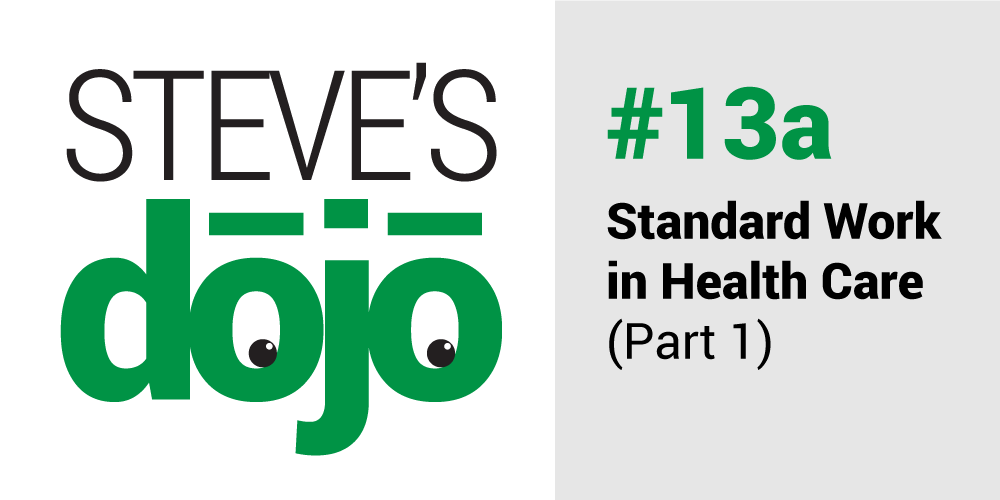Stevenote:
Standard Work
/stan∙derd wurk/ noun
Standard work is a noun, not an adjective preceding a noun. It’s not, “work that’s standard.” And, “standardized work,” isn’t a synonym. Linguistically and semantically, “standard work,” is one thing, just like your back yard is one thing.
If you said to me, “My yard is back,” I’d ask where it had recently been. That statement is not some Yoda-esque twist of the language. Wrong, it is. Therefore it’s situation normal in most organizations to have work processes which are standard yet have no standard work.
ou’re a value expert, and so you’ll likely be asked questions like “why can’t we implement something I saw in x factory?”
I set out to answer that question in this post. The short answer is no, we don’t implement techniques directly from manufacturing because health care is different than manufacturing in several important ways.
Here is a more detailed explanation:
We teach standard work here at University of Utah Health from a services perspective. This difference may cause confusion as some improvers learn about it from other sources focused on manufacturing environments.
In a services environment, delivering value means interacting with our customers in our space as we perform our work.
This situation is very different from a manufacturing environment which customers never see (excepting plant tours) and don’t directly influence. In the US, the locus of lean thinking is still manufacturing because manufacturing is still the largest sector of our economy. Health care is sixth. Thanks to technological advancement and continuous process improvement (and contra political rhetoric) the current era of US manufacturing is stronger than any other in terms of output.
We limit the discussion of standard work in our curriculum to the elementary: a definition, a few examples, and a greenbelt homework assignment. If you go a little further you can find thousands of pages (web and dead tree) and full training courses on the subject.
I spent a few minutes on the intertubes reading the online definitions. The majority of definitions are manufacturing-centric and emphasize these three basic elements:
- Work sequence
- Takt time (customer demand rate)
- Standard inventory throughout the process (aka WIP)
In our standard work curriculum, we de-emphasize the last two bullets. Here’s why:
The complications of takt time in health care
Manufacturers can design a pull system according to takt time (customer demand rate) with relatively high precision because their customers are at the end of the process, not flowing along with it. (Owners of custom design-build shops would raise a hand in protest at such a blanket assertion, but they’re too busy dealing with customer change-orders.) The supply and demand relationship within health care markets is fundamentally perverse and this complicates the notion of takt time. Furthermore, in health care delivery, our customer comes along with us throughout the experience, injecting their variation all along the way.
Why in-process inventory is not a standard work requirement in health care
Manufacturers process raw material into finished goods with a keen awareness that inventory is cash, temporarily transformed. They know that their factory is just one series of links in the larger value chain that starts with mother nature and ends with the consumer. This realization spawned just-in-time inventory management science that minimizes inventory levels at each step in the chain. In-process inventory would be extraneous information in many health care standard work situations because we provide health information and care; inventory is not the main event. On this topic, in case you hadn’t heard, we are very good at managing the supply chain.
Core requirements of standard work in health care
- Represents best practice, minimizing variability and preventing errors, based on data and expert consensus
- Sequence of steps (turnaround time of each step is nice but you can do a lot of good without them)
- Appropriate visuals
- Thoughtful on word count, white space, and layout
- It must be visual
- It is integrated into the flow of the work, always accessible, literally in an instant
In our curriculum, standard work and forcing functions are discussed as cousin topics, both in the service of helping get the process right.
In the next post, I share some examples and some opportunities for standard work in clinical settings.
Steve Johnson
Why do we like pie charts so much? Because it’s food? Is it the fun colors? Are we soothed by the paradox of an unending cycle implied by something so perfectly complete? Elton John’s lyrics are true, no? “All are agreed as they join the stampede...” pie charts are overused.
Every Thanksgiving, Accelerate’s Marcie Hopkins makes not just one, but multiple pies to enjoy. To maximize efficiency, she teamed up with Farmington manager Matt Sanford to design the perfect process. And—of course—there’s a health care application as well.
Improvement science is about making everyday tasks easier and faster. This week, Steve uses the 6-phase value improvement methodology to build a highly-reliable morning routine.
